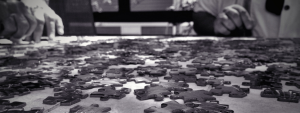Behind the Scenes of a Conference Part III – Building the Program
This post is the third in a series of posts that look behind the scenes at how we build a conference program.
In the first two posts in this series, Bianca Woods looked at the criteria we use when evaluating a session proposal. In the second post, Mark Britz looked at the discussions and debates that take place when selecting sessions that could be part of the program.
In this post, I will look at how we actually build a conference program from the selected sessions. Before I talk about how we build a program from the different sessions we have identified as being worthy of being on the program, I think we need to look at the numbers we’re dealing with so we can put this next stage into context.
The Math of Conference Programming
An average conference may have 150 speaking opportunities. We receive 400-700 proposals for each conference we host, and after we evaluate them all, we usually have at least 200-250 proposals that were flagged as “yes”; that number jumps to 400 or 500 if you include those flagged as ‘maybe”.
This is where the math of one of our conferences breaks down; there are always more proposals flagged as ‘yes’ than we have room for on a program.
A Jigsaw Puzzle with Too Many Pieces

Via CC license from Kevin Dooley http://bit.ly/2vxVMEq
Building a conference program is very much like building a jigsaw puzzle. Each session is an individual piece, and the overall program is the final design. Much like a jigsaw puzzle, building a program involves moving pieces around to find out where they fit best within the overall design.
However, there’s one major difference between a jigsaw puzzle and a conference program. Imagine a jigsaw puzzle that used 150 pieces to build the design, but the box contained 250 pieces, and you needed to figure out which pieces to use to build the final design.
If that concept leaves you a little confused, welcome to the world of conference programming. In the first two stages of vetting conference proposals, what we’re doing is answering a pretty basic question: Is this proposal a match for the conference? During this last phase we move pieces in, out, and around the conference framework until the best program emerges.
Let’s look at what this all looks like in practice.
Why We Meet Face-To-Face
So far I’ve explained what we do during this stage, but not how we do it. We are a very digital company. We leverage digital tools to collaborate and connect daily. There’s really nothing that is done in a face-to-face environment that we couldn’t accomplish using digital tools.
Despite this fact, we still find it valuable to get together face-to-face for this stage. Part of the reason we do this is because we find that this stage works best if we do it in a single setting. Where the previous stages actually work best in shorter meetings spread out over a few days or weeks, the process of actually building a program works best for us when we allocate a day or two to just work through the whole program start-to-finish, and we find we can do that easier if we are all in the same physical space.
Another reason we meet face-to face is that the process of building a program is very complex. We generally use all of the wall space we have available when building a program, and it’s just easier to collaborate in the same room then by trying to fit all of that information onto small computer screens.
Building a Digital Conference Using Analog Tools
Despite the fact that we use digital collaboration told daily and the fact that our conferences also focus on the use of digital technologies for learning, we like to meet face to face because we actually have a very analog process for building a program. In fact, it’s almost entirely paper-based.
Before we get together I generally prepare the tools for our meeting. This consists of two major components:
- I will use flip charts to build grid schedule for the entire conference. Each spot is about four inches square – that will be important later – and represents a single session.
- I will also print out small labels for all of the YES sessions that are eligible to be on the program.
I bring these charts and labels to the meeting, and then the fun begins.
What Building a Conference Program Looks Like

Photo via CC License from Dean Hochman http://bit.ly/2vxmqgC
Our day starts with applying printed labels to Post-It Notes so we can easily move them around the agenda slots throughout the day. Each label has on it a number of pieces of information, but the most important piece of information for this stage is the track (or category) that has been associated with the session.
We assign a different colored Post-It Note for each track. This makes it very easy for us to see, at a glance, how our tracks are spread out across the conference.
Once the Post-It Notes are set, the process of actually building the conference program can begin.
The Key Factors Used to Balance a Program
 I won’t bore you with all of the factors that we use to balance a program, but I will share some of the “bigger rocks” that are critical to us.
I won’t bore you with all of the factors that we use to balance a program, but I will share some of the “bigger rocks” that are critical to us.
- Balancing the Tracks: If you’re interested in a specific track of sessions, we want to make sure you have options for those sessions throughout the conference.
- Balancing Speakers: While some speakers may submit multiple proposals that are worth putting on the program, we start from a place where no speaker gets more than one session. This enables us to include more members of our community at each conference.
- Balancing Companies: Similarly to the way we balance speakers, we want to make sure we are also accommodating different companies from our community.
- Balancing Popular Speakers: There are some speakers that are well known and usually draw a larger crowd. We try to make sure those sessions are spread out to minimize attendees missing out on a session they really wanted to see.
- Accommodating Speaker Constraints: Some speakers aren’t available throughout the entire conference. Making sure we only schedule a speaker on days he or she is available is critical.
- Reserving 20% of slots for new speakers: Bringing in new voices is very important to us, so we always allocate about 20% of each program to first-time speakers.
- Balancing Consultant, Practitioner, and Vendor sessions: Each of these groups brings an important perspective on the work we do, so we look to balance each perspective across the program.
- Balancing Bring Your Own Laptop Sessions: We have sessions that are specifically designed as a hands-on experience, and they are scheduled in rooms set up for that purpose. As such, we make sure these sessions are spread out across the event.
Balance: A Simple Word, A Complex Process
Balance is the one word that drives how we build a conference program. The factors I shared in this post are just a few of a huge number of factors that we take into account when building a program. Each of those factors is applied to the program via a specific discussion and action that we take.
This can result in a very complex process. Let me walk you through what this looks like in general terms.
- Perform a series of tasks in order to balance the program for Factor #1
- Perform a series of tasks in order to balance the program for Factor #2
- Check to make sure the balancing for Factor #2 did not take Factor #1 out of balance; rebalance for Factor #1 if necessary.
- Perform a series of tasks in order to balance the program for Factor #3
- Check to make sure the balancing for Factor #3 did not take Factors #1 & #2 out of balance; rebalance for Factors #1 & #2 if necessary.
For our conferences there can easily be two dozen factors that we apply to a program, so you can see how quickly the complexity of building and balancing a program can ramp up.
Finalizing and Posting the Program
After about two days of balancing and rebalancing the program, the jigsaw puzzle is finally complete. The “extra pieces” to the puzzle – those sessions that were worthy of being on the program but didn’t make the final cut – become our list of alternates.
From there it’s a matter of editing session descriptions and getting them posted online. It’s almost as if the task of building the program is complete.
Almost…
There’s a maintenance aspect to building a program that takes place in the months leading up to a program. This is a critical aspect of maintaining the quality of our programs that we place great importance on, and it’s what makes our alternate list so important.
Bianca Woods will expand upon this need in the final post in this series, Behind the Scenes of a Conference Part IV– What About Cancellations?.

Leave a Reply